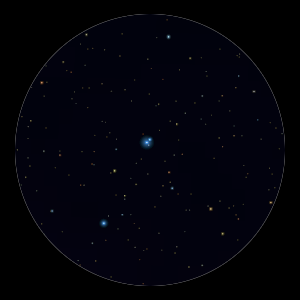by Dave Blane — 2014 March 27
This month’s star is a fine binocular triple system in the constellation of Centaurus and delta, the brightest of the three, has an apparent visual magnitude of +2.5 and so is easily visible to the naked eye.

Discovered by William Stephen Jacobs and designated JC2, delta Centauri shares a common proper motion with the nearby stars HD 105382 and HD 105383, so they form a small asterism and perhaps a triple star system.
All three are spectral class B stars and delta Cen (A) has a magnitude of 2.5 while HD105382 (B) and HD105383 (C) have magnitudes of 4.4 and 6.4 respectively. Based upon parallax measurements, delta is located at a distance of about 410 light-years (130 parsecs) from the Earth.
The Cambridge Double Star Atlas describes them as a “very bright, bluish trio – superb in binoculars” and through a small telescope appear as a striking blue-white triple.
Delta Centauri is a variable star with a brightness that varies from magnitude +2.51 to +2.65. This variability can be successfully modelled as a Gamma Cassiopeiae type variable, also known as a shell star. The energy from this star is being radiated at an effective temperature of over 22,000 K from the outer envelope, giving it the blue-white hue of a B-type star. It has a radius of 5.9 times the radius of the Sun and 8.6 times the Sun’s mass.
Some of the variation in this star may be explained by assuming it is a binary starsystem. This proposed secondary star would need to have about 4–7 times the Sun’s mass and be orbiting with a period of at least 4.6 years at a minimum separation of 6.9 Astronomical Units.
I measured the system in 2011 with a 150mm refractor and found separation and position angle to be 268.4” and 325° respectively for A-B while the values for A-C were 216.9” and 227°. There has been little change since the first recorded measurement in 1847.

- Browse the Newsletter Archives.
